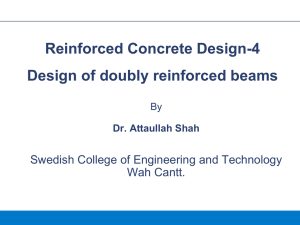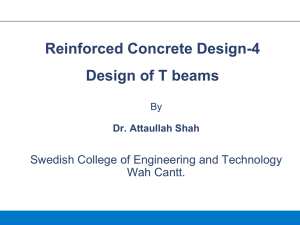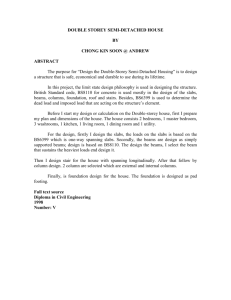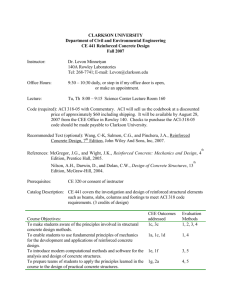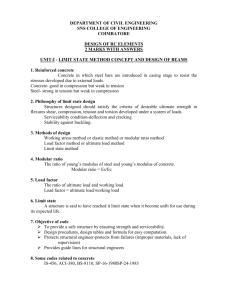Lecture 4 - Fundamentals
advertisement
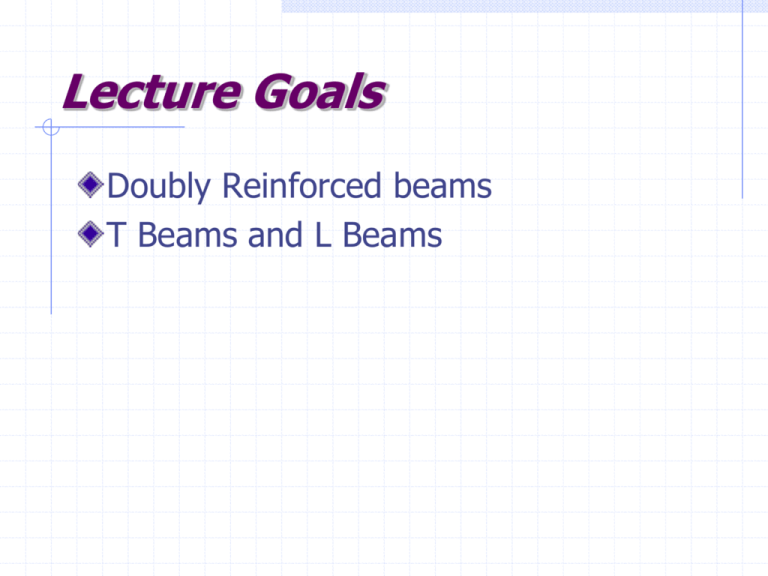
Lecture Goals Doubly Reinforced beams T Beams and L Beams Analysis of Doubly Reinforced Sections Effect of Compression Reinforcement on the Strength and Behavior Less concrete is needed to resist the T and thereby moving the neutral axis (NA) up. T As f y C T Analysis of Doubly Reinforced Sections Effect of Compression Reinforcement on the Strength and Behavior Singly Reinforced a1 C Cc ; M n As f y d 2 Doubly Reinforced a2 C Cc Cs ; M n As f y d 2 and a2 a1 Reasons for Providing Compression Reinforcement Reduced sustained load deflections. Creep of concrete in compression zone transfer load to compression steel reduced stress in concrete less creep less sustained load deflection Reasons for Providing Compression Reinforcement Effective of compression reinforcement on sustained load deflections. Reasons for Providing Compression Reinforcement Increased Ductility reduced stress block depth increase in steel strain larger curvature are obtained. Reasons for Providing Compression Reinforcement Effect of compression reinforcement on strength and ductility of under reinforced beams. r rb Reasons for Providing Compression Reinforcement Change failure mode from compression to tension. When r > rbal addition of As strengthens. Compression zone allows tension steel to yield before crushing of concrete. Effective reinforcement ratio = (r r’) Reasons for Providing Compression Reinforcement Eases in Fabrication - Use corner bars to hold & anchor stirrups. Effect of Compression Reinforcement Compare the strain distribution in two beams with the same As Effect of Compression Reinforcement Section 1: T As f s T Cc1 0.85 f c ba 0.85 f c b1c1 As f s c1 0.85 f c b1 Section 2: T As f s T Cs Cc1 As f s 0.85 f c ba2 As f s 0.85 f c b1c2 As f s As f s c2 0.85 f c b1 Addition of A’s strengthens compression zone so that less concrete is needed to resist a given value of T. NA goes up (c2 <c1) and es increases (es2 >es1). Doubly Reinforced Beams Four Possible Modes of Failure Under reinforced Failure ( Case 1 ) Compression and tension steel yields ( Case 2 ) Only tension steel yields Over reinforced Failure ( Case 3 ) Only compression steel yields ( Case 4 ) No yielding Concrete crushes Analysis of Doubly Reinforced Rectangular Sections Strain Compatibility Check Assume es’ using similar triangles e s 0.003 c c d ' c d ' e * 0.003 s c Analysis of Doubly Reinforced Rectangular Sections Strain Compatibility Using equilibrium and find a T Cc Cs a As As f y 0.85 f cb As As f y r r ' d f y c 1 1 0.85 f cb 1 0.85 f c a Analysis of Doubly Reinforced Rectangular Sections Strain Compatibility The strain in the compression steel is d e s 1 e cu c 1 0.85 f c d 1 0.003 r r ' d f y Analysis of Doubly Reinforced Rectangular Sections Strain Compatibility Confirm e s e y fy Es ; es e y 1 0.85 f c d fy fy e s 1 0.003 3 Es 29 x 10 ksi r r ' d f y Analysis of Doubly Reinforced Rectangular Sections Strain Compatibility Confirm 1 0.85 f c d f y 87 87 r r ' d f y 1 0.85 f c d 87 r r ' 87 f d f y y Analysis of Doubly Reinforced Rectangular Sections Find c As f y 0.85 f c ba As f y c Ass As f y 0.85 f c b1 a 1c confirm that the tension steel has yielded fy d c es e cu e y Es c Analysis of Doubly Reinforced Rectangular Sections If the statement is true than a M n As As f y d As f y d d 2 else the strain in the compression steel f s Ee s Analysis of Doubly Reinforced Rectangular Sections Return to the original equilibrium equation As f y As f s 0.85 f cba AsEse s 0.85 f cb1c d AsEs 1 e cu 0.85 f cb1c c Analysis of Doubly Reinforced Rectangular Sections Rearrange the equation and find a quadratic equation d As f y AsEs 1 e cu 0.85 f cb 1c c 2 0.85 f cb 1c AsEse cu As f y c AsEse cu d 0 Solve the quadratic and find c. Analysis of Doubly Reinforced Rectangular Sections Find the fs’ d d f s 1 Ese cu 1 87 ksi c c Check the tension steel. fy d c es e cu e y Es c Analysis of Doubly Reinforced Rectangular Sections Another option is to compute the stress in the compression steel using an iterative method. 0.85 f d 1 c 3 fs 29 x 10 1 0.003 r r ' d f y Analysis of Doubly Reinforced Rectangular Sections Go back and calculate the equilibrium with fs’ Af T C C a s y c c a 1 As fs 0.85 f cb s Iterate until the c value is adjusted for the fs’ until the stress converges. d f s 1 87 ksi c Analysis of Doubly Reinforced Rectangular Sections Compute the moment capacity of the beam a M n As f y As f s d As f s d d 2 Limitations on Reinforcement Ratio for Doubly Reinforced beams Lower limit on r r min 3 f c 200 fy fy same as for single reinforce beams. (ACI 10.5) Example: Doubly Reinforced Section Given: f’c= 4000 psi fy = 60 ksi A’s = 2 #5 As = 4 #7 d’= 2.5 in. d = 15.5 in h=18 in. b =12 in. Calculate Mn for the section for the given compression steel. Example: Doubly Reinforced Section Compute the reinforcement coefficients, the area of the bars #7 (0.6 in2) and #5 (0.31 in2) As 4 0.6 in 2 2.4 in 2 As 2 0.31 in 2 0.62 in 2 As 2.4 in 2 r 0.0129 bd 12 in.15.5 in. As 0.62 in 2 r 0.0033 bd 12 in.15.5 in. Example: Doubly Reinforced Section Compute the effective reinforcement ratio and minimum r reff r r 0.0129 0.0033 0.00957 200 200 r 0.00333 fy 60000 3 f c 3 4000 or 0.00316 fy 60000 r r min 0.0129 0.00333 OK! Example: Doubly Reinforced Section Compute the effective reinforcement ratio and minimum r 1 0.85 f c d 87 r r ' d fy 87 f y 0.85 0.85 4 ksi 2.5 in. 87 0.0398 87 60 60 ksi 15.5 in. 0.00957 0.0398 Compression steel has not yielded. Example: Doubly Reinforced Section Instead of iterating the equation use the quadratic method 0.85 f cb 1c 2 AsEse cu As f y c AsEse cu d 0 0.85 4 ksi 12 in. 0.85 c 2 0.62 in 2 29000 ksi 0.003 2.4 in 2 60 ksi c 0.62 in 2 29000 ksi 0.003 2.5 in. 0 34.68c 2 90.06c 134.85 0 c 2 2.5969c 3.8884 0 Example: Doubly Reinforced Section Solve using the quadratic formula c 2.5969c 3.8884 0 2 c 2.5969 c 3.6595 in. 2.5969 2 2 4 3.8884 Example: Doubly Reinforced Section Find the fs’ d 2.5 in. fs 1 Ese cu 1 87 ksi c 3.659 in. 27.565 ksi Check the tension steel. 15.5 in. 3.659 in. es 0.003 0.00971 0.00207 3.659 in. Example: Doubly Reinforced Section Check to see if c works c As f y As fs 0.85 f c 1b 2 2 2.4 in 60 ksi 0.62 in 27.565 ksi c 3.659 in. The problem worked 0.85 4 ksi 0.8512 in. Example: Doubly Reinforced Section Compute the moment capacity of the beam a M n As f y As fs d As f s d d 2 2.4 in 2 60 ksi 0.85 3.659 in. 15.5 in. 2 2 0.62 in 27.565 ksi 0.62 in 2 27.565 ksi 15.5 in. 2.5 in. 1991.9 k - in. 166 k - ft Example: Doubly Reinforced Section If you want to find the Mu for the problem c 3.66 in. 0.236 d 15.5 in. From ACI (figure R9.3.2)or figure (pg 100 in your text) c 0.375 > d 0.9 The resulting ultimate moment is M u M u 0.9 166 k - ft 149.4 k - ft Analysis of Flanged Section Floor systems with slabs and beams are placed in monolithic pour. Slab acts as a top flange to the beam; Tbeams, and Inverted L(Spandrel) Beams. Analysis of Flanged Sections Positive and Negative Moment Regions in a T-beam Analysis of Flanged Sections If the neutral axis falls within the slab depth analyze the beam as a rectangular beam, otherwise as a T-beam. Analysis of Flanged Sections Effective Flange Width Portions near the webs are more highly stressed than areas away from the web. Analysis of Flanged Sections Effective width (beff) beff is width that is stressed uniformly to give the same compression force actually developed in compression zone of width b(actual) ACI Code Provisions for Estimating beff From ACI 318, Section 8.10.2 T Beam Flange: L beff 4 16hf bw bactual ACI Code Provisions for Estimating beff From ACI 318, Section 8.10.3 Inverted L Shape Flange L beff bw 12 6hf bw bactual bw 0.5* clear distance to next web ACI Code Provisions for Estimating beff From ACI 318, Section 8.10 Isolated T-Beams bw hf 2 beff 4bw Various Possible Geometries of T-Beams Single Tee Twin Tee Box
